BrightnessAndDisplays
|
Size: 1174
Comment: initial draft
|
Size: 3675
Comment: clarifies automatic brightness algorithm
|
| Deletions are marked like this. | Additions are marked like this. |
| Line 11: | Line 11: |
| The “Display brightness:” slider should be sensitive regardless of whether “Adjust automatically” is on or off. If it is on and you adjust the brightness manually, the function that determines the automatic brightness should be adjusted such that, in future, the current ambient light value would result in your new manual setting being automatic. | The goal of the “Adjust automatically” setting is to maximize the average time you can use the device before feeling the need to adjust brightness manually. This is achieved by frequently adjusting the emitted brightness of the display based on the ambient brightness of the surroundings. So there is a function representing the emitted brightness desired at each level of ambient brightness detectable by the light sensor. |
| Line 13: | Line 13: |
| {{attachment:phone-brightness-curve.png}} | {{attachment:phone-brightness-curve-automatic.png}} |
| Line 15: | Line 15: |
| Whenever “Invert black and white” is on, the display should be rendered such that value is inverted, while hue and shade are unchanged. For example, white should be rendered as black and vice versa, pale blue as navy and vice versa, pink as maroon and vice versa, and mid-grey left unchanged. | Because different hardware has different light sensors and displays, this function should be settable based on the hardware model. Because users have different preferences, the function should also be user-adjustable. This should be achieved by altering the display brightness manually while “Adjust automatically” is checked. Therefore, the “Display brightness:” slider should be sensitive regardless of whether “Adjust automatically” is checked or unchecked. If it is checked and you adjust the brightness manually, the function that determines the automatic brightness should be adjusted such that, in future, the current ambient light value would result in your just-chosen brightness being chosen automatically. To achieve this, the function that generates emitted brightness ''E'' from the ambient brightness ''A'' should be a curve connecting from three to five coordinates of (''A'', ''E''). Where ''A'',,min,,, ''A'',,max,,, ''E'',,min,,, and ''E'',,max,, are the minimum and maximum possible values: * If you (or the default values for the handset model) set ''E'',,min,, at ''A,,p,,'' > ''A'',,min,,, the function should include ''E'' = ''E'',,min,, for ''A'',,min,, ≤ ''A'' ≤ ''A,,p,,''. {{attachment:brightness-curve-automatic-flat-minimum.png}} * If you (or the default values for the handset model) set ''E'',,max,, at ''A,,q,,'' < ''A'',,max,,, the function should include ''E'' = ''E'',,max,, for ''A,,q,,'' ≤ A ≤ ''A'',,max,,. {{attachment:brightness-curve-automatic-flat-maximum.png}} * If you manually set a brightness (''A,,r,,'', ''E,,r,,'') where any previously-set points exist with ''A'' ≤ ''A,,r,,'' and ''E'' > ''E,,r,,'', those other points should be discarded from the curve, so that the screen does not brighten when surroundings dim. * If you manually set a brightness (''A,,s,,'', ''E,,s,,'') where any previously-set points exist with ''A'' ≥ ''A,,s,,'' and ''E'' < ''E,,s,,'', those other points should be discarded from the curve, so that the screen does not dim when surroundings brighten. {{attachment:brightness-curve-automatic-discard-overbright.png}} {{attachment:brightness-curve-automatic-discard-overdim.png}} * If you manually set a brightness such that the set of coordinates includes more than one for which ''A'',,min,, < ''A'' < ''A'',,max,,'' and ''E'',,min,, < ''E'' < ''E'',,max,,'', all of them except the newest one should be discarded, so that the curve is not too complex. * A new brightness curve should not be saved until you dismiss the brightness slider you are using (for example, by closing the indicator menu), so that a brief experiment does not obliterate a careful previous curve. |
PC
We assume that any PC has a hardware brightness control, on either the keyboard or the display itself. And unlike sound volume, brightness does not need reassurance for troubleshooting purposes. Therefore, brightness should not have software UI as well; that would be redundant.
If you use a keyboard key to adjust brightness, a brightness notification bubble should appear.
Phone
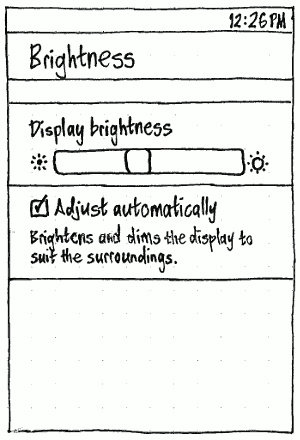
The goal of the “Adjust automatically” setting is to maximize the average time you can use the device before feeling the need to adjust brightness manually. This is achieved by frequently adjusting the emitted brightness of the display based on the ambient brightness of the surroundings. So there is a function representing the emitted brightness desired at each level of ambient brightness detectable by the light sensor.
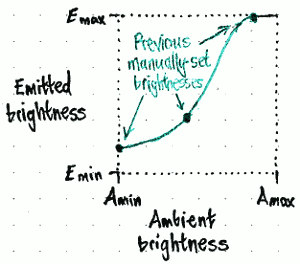
Because different hardware has different light sensors and displays, this function should be settable based on the hardware model.
Because users have different preferences, the function should also be user-adjustable. This should be achieved by altering the display brightness manually while “Adjust automatically” is checked. Therefore, the “Display brightness:” slider should be sensitive regardless of whether “Adjust automatically” is checked or unchecked.
If it is checked and you adjust the brightness manually, the function that determines the automatic brightness should be adjusted such that, in future, the current ambient light value would result in your just-chosen brightness being chosen automatically.
To achieve this, the function that generates emitted brightness E from the ambient brightness A should be a curve connecting from three to five coordinates of (A, E). Where Amin, Amax, Emin, and Emax are the minimum and maximum possible values:
If you (or the default values for the handset model) set Emin at Ap > Amin, the function should include E = Emin for Amin ≤ A ≤ Ap.
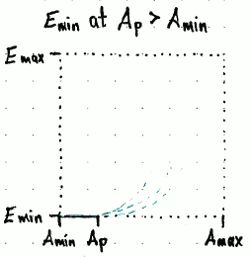
If you (or the default values for the handset model) set Emax at Aq < Amax, the function should include E = Emax for Aq ≤ A ≤ Amax.
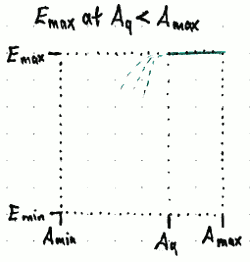
If you manually set a brightness (Ar, Er) where any previously-set points exist with A ≤ Ar and E > Er, those other points should be discarded from the curve, so that the screen does not brighten when surroundings dim.
If you manually set a brightness (As, Es) where any previously-set points exist with A ≥ As and E < Es, those other points should be discarded from the curve, so that the screen does not dim when surroundings brighten.
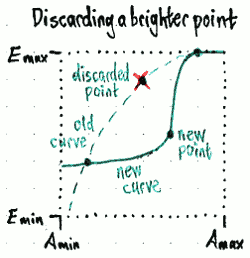

If you manually set a brightness such that the set of coordinates includes more than one for which Amin < A < Amax and Emin < E < Emax, all of them except the newest one should be discarded, so that the curve is not too complex.
- A new brightness curve should not be saved until you dismiss the brightness slider you are using (for example, by closing the indicator menu), so that a brief experiment does not obliterate a careful previous curve.
BrightnessAndDisplays (last edited 2016-10-17 13:01:11 by mpt)